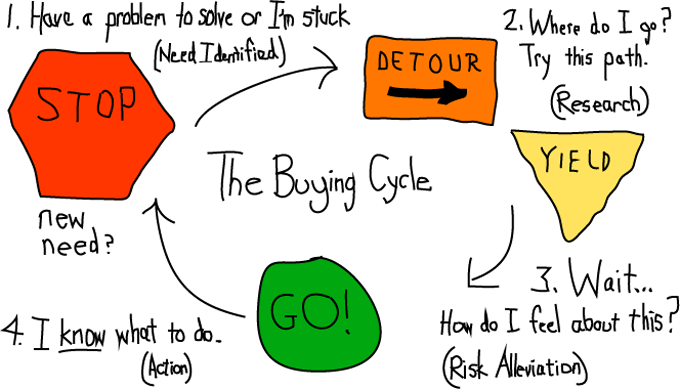Updated November 16, 2021
Reading Time: 3 minutes
Visitors > Conversions
Lead generation and online conversions are the lifeblood of a website. But to do it, you need to understand how your target market buys what you offer and how that maps to your website’s SEO architecture. First of all, there is no one definition of The Buying Cycle. Essentially though, all explanations contain the same basics. Here’s the model we use to create a website’s structure and content, effectively supporting online conversion:
The Buying Cycle
Stage 1 – Awareness of Need
The potential buyer recognizes a need and is looking for options. For example, you need a new cell phone. What different types are available? Do you need a new phone plan? Your needs will be very different if you like to watch streaming video (requires large amounts of data to download) or if you have a teenager on your plan (need for unlimited texts). Once you’ve figured out your need, the direction of your research may shift.
Stage 2 – Research
The potential buyer determines a Refined Need. This is where reviews are read, various models and features are considered, and costs compared. Using our cell phone example, this is where you evaluate smartphones versus a conventional phone. You’ll weigh data plans, touchpad vs. a keypad, an iPhone or an Android, etc. This is where your research will get more specific (hint: longer search phrases). At this stage, the purpose is to educate yourself on what’s available in the marketplace not necessarily to buy right now.
Stage 3 – Risk Alleviation & Consideration
This is the most subjective phase. Potential buyers are wondering “how do I feel about these choices?” They are looking at all the various options gathered in the research phase and considering how each is going to fill their need. This could also be called the “test drive” stage. This is where you might want to visit a retail store to see a certain type of phone. Or, you play around with a friend’s phone to see how easy it is to text or watch a video. At this point, you may also look into phone insurance in case you have a tendency to drop or lose your phone.
Stage 4 – Action
The buyer is ready to make a decision. The only question remaining is where to make the purchase. Do you buy it online or go to a store? There are many factors that affect the Action stage. For some buyers, it may depend simply on the type of purchase. Or, the dollar amount may be the hurdle. This is where knowing the habits of your target market are required. You may feel perfectly comfortable buying a $20 phone accessory from Amazon but aren’t willing to plunk down $200 for a new phone online regardless of their return policy and satisfaction guarantees. Knowing your target market’s preferences is critical in figuring out how to present your solution and ultimately drive an online conversion.
What does all this have to do with SEO?
Ah, here’s the really important part. Your potential clients are looking for different kinds of answers at each stage of the buying cycle. Give them what they seek!
If you can recognize the stage that your keywords are targeting, and focus content appropriately, then – voila! The value of your site increases. Search engines will recognize this by taking into account user behavior (lower bounce rates, longer average visits, more incoming links), and of course, the relevant text.
Additionally, keep in mind that the stages don’t all happen at once. Judging the success of your strategy requires appropriate measurements (i.e., more than just sales) and patience. Using Web Analytics to define funnels, or paths to completing a goal can help accomplish this.


 Will the EU Force Google to Explain their Ranking Algorithm?
Will the EU Force Google to Explain their Ranking Algorithm?